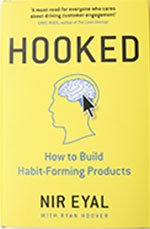‘Hooked’, by Nir Eyal

Simply sign up to the Business education myFT Digest -- delivered directly to your inbox.
Digital detoxes are a thing. For a night, a weekend, or longer, email junkies go to WiFi blackspots, turn off their smartphones, lock up their tablets and decompress. They remind themselves what it is like to give up that dose of dopamine that arrives with the appearance of a new message or a new “like” on an Instagram snap.
After all, as Nir Eyal points out in the opening pages of his new book, Hooked: How to Build Habit-Forming Products (Portfolio Penguin, £12.99), one-third of Americans say they would rather give up sex than forgo their mobile phones. Most look at theirs within 15 minutes of waking. We are, as the title says, hooked.
This dependence on technology, the urge to check our messages, our emails, our Pinterest accounts, our Twitter stream, our Facebook likes, is startling. It is analysed by Eyal, who has worked in the video gaming and advertising industries and taught courses at Stanford Graduate School of Business on consumer psychology.
In this short and punchy book, he draws on behavioural economics and neuroscience to examine why some products, games and television shows become habits, while others sink. This is useful knowledge for entrepreneurs, marketers and designers. Creating something that brings people back for more is crucial to generating followers, viewers, consumers and revenues.
It is also of wider significance. Quoted in the book is Paul Graham, a Silicon Valley investor: “Unless the forms of technological progress that produced these things are subject to different laws than technological progress in general, the world will get more addictive in the next 40 years than it did in the last 40.”
Building habits is, according to Eyal, a four-step process; or as he calls it, “the hook model”. The first is to identify the trigger. For some, it may be Fomo, or fear of missing out. Then there is action. As Eyal describes it, the trigger informs the user of what to do next. “To initiate action, doing must be easier than thinking,” he asserts. This is followed by the “variable reward”, such as retweets or Facebook likes. Finally, there is investment (of time rather than money) which, Eyal says, explains why so many people stay with Twitter rather than better micro-blogging sites. Because the experience depends on building connections and followers (the investment), people are reluctant to walk away.

This all makes sense. Using Eyal’s hook model, it is easy to see how tweeting has become a habit. Yet things are often obvious in retrospect. Social psychologists and behavioural economists are good at identifying what made people do certain things but not at predicting what they will do. The author charts the appeal of Zynga’s game, Farmville: in 2010, there were 83.8m active users a month yet two years later, Zynga’s star had waned. Eyal’s verdict? That this just shows predictable experiences become boring and evidence of “finite variability” — which seems like the author’s get-out clause.
Another example of a habit, he says, was the television series, Breaking Bad , which tells the story of Walter White, a chemistry teacher who on receiving a cancer diagnosis starts cooking crystal meth to raise money. At the heart of every episode is a problem in need of resolution, such as disposing of the bodies of two rival drug dealers. And so, the author concludes, the show follows his four rules of habit-forming. Well yes, but there are probably thousands of other scripts with the same storytelling formula that never made it to our television screens. So while The Hook provides an intriguing framework to test prototypes, it does not suggest a recipe for success.
But it raises questions about the morality of manipulation. Eyal concludes the creators of habit-forming technology fall into four camps: facilitators, peddlers, entertainers and dealers. According to him, “dealers” are people who “neither use the product nor believe it can improve people’s lives. They have the lowest chance of finding long-term success and often find themselves in morally precarious positions.”
This is debatable but raises the question of what might have happened if only Walter White had paid attention to the perils of being a dealer.
Comments